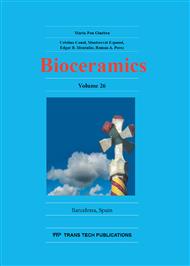p.402
p.408
p.414
p.420
p.426
p.430
p.435
p.443
p.448
Bioceramic Materials Show Reduced Pathological Biofilm Formation
Abstract:
The aim of the present work was to assess the surface ability of three bioceramic materials (A: alumina BIOLOX®forte; B: Si3N4; C: alumina matrix composite BIOLOX®delta) to inhibit bacterial biofilm formation. For this purpose, ceramic disks at standardized roughness (Ra = 0,25 μm) were used as test materials while commercial polystyrene was considered as control. Two biofilm-producing bacterial strains (S. epidermidis ATCC14990, Escherichia coli ATCC25922) were used for experiments. The viable biomass was assessed by the metabolic MTT assay after 24h incubation. Morphological data regarding biofilms structure were obtained by scanning electron microscopy. In general, results revealed that all bioceramics materials were significantly less colonized compared to polystyrene. The degree of biofilm formation onto bioceramics ranged between about 30 to 60% less than the polystyrene control. Moreover, some differences were noticed by comparing the three bioceramics inhibition ratio: bioceramic A showed significanlty less S. epidermidis biofilm formation (p<0.005) compared to B and C that showed similar performance. Conversely, no difference were noted for E. coli biofilm amount for A, B and C. In conclusion, the tested materials showed capability to reduce biofilm formation to a different extent depending on the tested bacterial strains.
Info:
Periodical:
Pages:
448-453
Citation:
Online since:
November 2014
Keywords:
Price:
Сopyright:
© 2015 Trans Tech Publications Ltd. All Rights Reserved
Share:
Citation:


